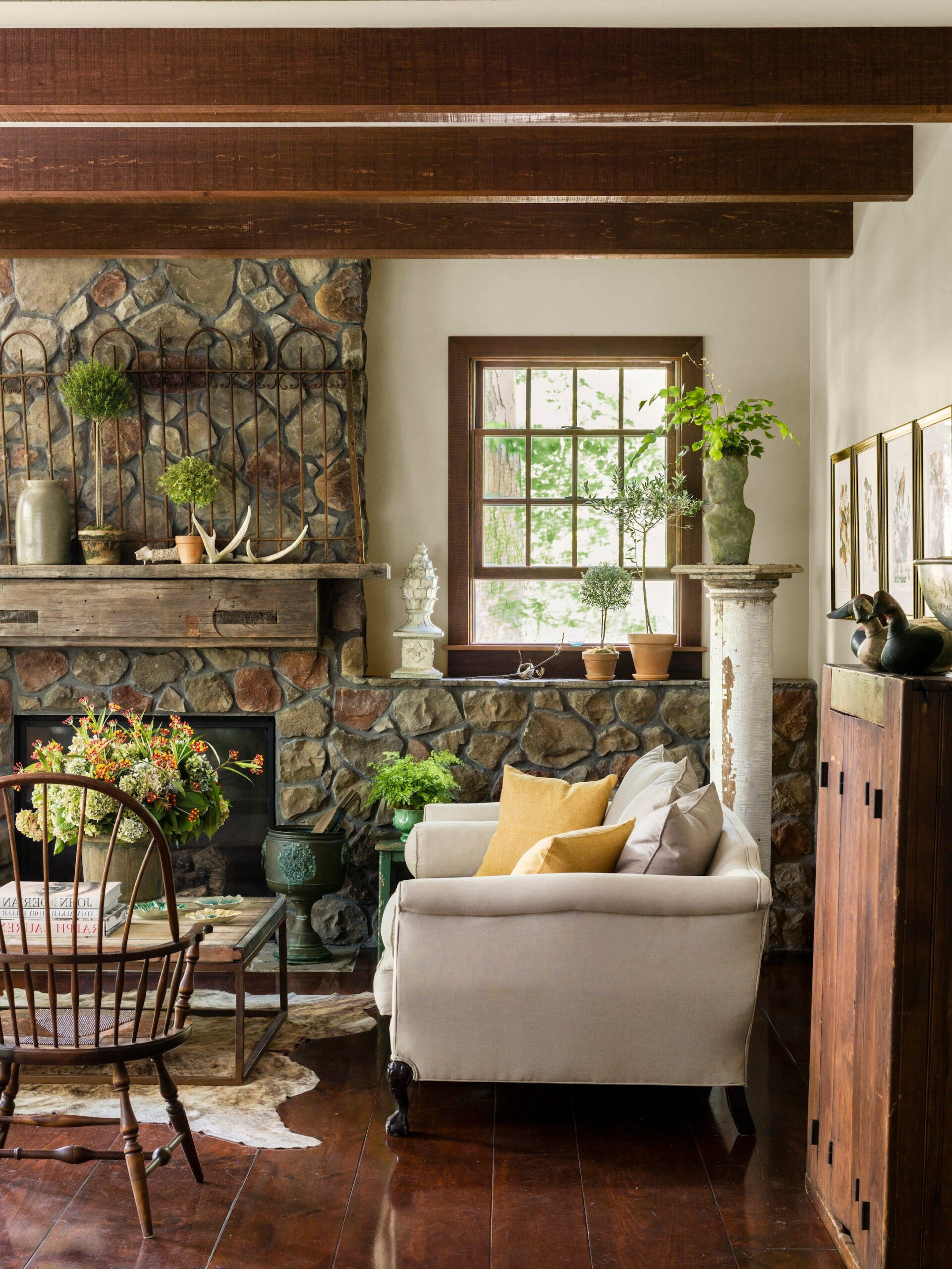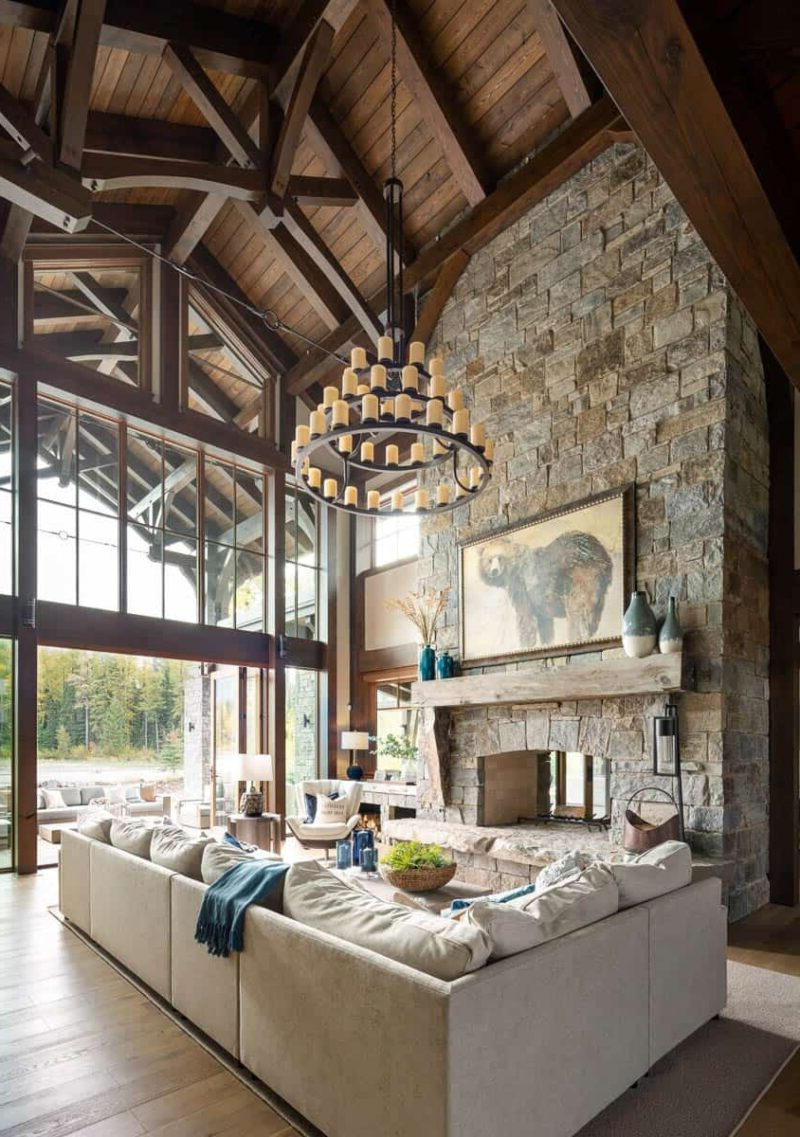There’s something deeply satisfying about stepping into a living room that feels like it’s been crafted by hand, where every piece tells a story. Rustic living spaces have gained popularity because they offer both warmth and character that mass-produced alternatives simply cannot match. But how do you create a space that’s both comfortable and full of rustic personality? It’s not just about using old wood or vintage furniture – it’s about understanding the essence of what makes a space feel truly lived-in and loved.
Rustic living rooms are more than just a design trend – they represent a return to authenticity and craftsmanship. These spaces embrace the beauty of imperfection, celebrating materials that have aged naturally and furniture that carries history. Whether you’re renovating an entire home or simply updating one room, creating a rustic living space that feels both comfortable and character-rich requires thoughtfulness and attention to detail. The key lies in balancing the raw, natural elements with the soft touches that make a house feel like a home.
Understanding the Core Elements of Rustic Design
Rustic design isn’t just about looking old or worn. It’s about honoring the natural qualities of materials and embracing the stories they carry. Think of exposed wooden beams, stone fireplaces, and weathered metal accents. These aren’t just decorative choices – they’re foundational elements that give rustic spaces their identity. What makes a truly successful rustic room is how well these elements work together. You might have a beautiful reclaimed barn door, but if the lighting is harsh or the seating is uncomfortable, the overall effect falls flat. The secret is in the layering – combining textures, materials, and colors in a way that feels intentional rather than forced. For instance, pairing a rough-hewn wooden coffee table with soft throw pillows creates that perfect balance between strength and comfort. Consider how each piece contributes to the overall feeling of the room. Does it add warmth? Does it tell a story? Does it invite you to sit down and stay a while?
Choosing the Right Materials for Maximum Comfort
Material selection is crucial when creating a rustic living room that feels inviting rather than cold. Natural fibers like wool, cotton, and linen work beautifully in rustic settings. They bring softness to hard surfaces and add visual warmth to the space. A chunky knit blanket draped over a rustic armchair isn’t just decorative – it makes the chair instantly more appealing to spend time in. Wood is central to rustic design, but not all woods are created equal. Choose pieces with character – knots, grain variations, and natural imperfections. These aren’t flaws; they’re features that make each piece unique. Stone elements, whether in a fireplace or accent wall, add grounding energy. The texture of stone brings a tactile quality that makes the space feel more substantial and real. When selecting materials, think about how they’ll age. Rustic spaces should improve with time, becoming more beautiful as they gather dust and stories. Consider how the materials will hold up to daily life – a well-chosen leather sofa will develop a rich patina over years of use, while a delicate fabric might show wear too quickly.
Layering Textures for Visual Interest and Comfort
The magic of rustic living rooms often happens in the details. Layering different textures creates depth and makes the space feel lived-in rather than staged. Think about combining rough wood with smooth stone, or soft fabrics against weathered metals. A woven area rug provides a cozy base that anchors the room. Throw pillows in various textures – velvet, cotton, and rope – add visual complexity and tactile interest. Consider incorporating natural elements like jute, sisal, or bamboo in your textiles. These materials not only provide visual contrast but also contribute to the organic feel of the space. The beauty of layering is that it allows you to gradually build your room’s character over time. You don’t need to buy everything at once. Start with one textured element and add others as you find them. Maybe a vintage tapestry adds warmth to a stark wall, or a collection of mismatched ceramic bowls brings color and interest to a mantelpiece. Each layer should enhance the overall feeling of comfort and authenticity.
Lighting That Enhances Rustic Ambiance
Lighting plays a crucial role in defining the mood of any rustic living space. Harsh overhead lights can immediately kill the cozy atmosphere you’re trying to create. Instead, opt for layered lighting that creates multiple zones of warmth. Pendant lights with Edison bulbs or wrought iron fixtures add character while providing functional illumination. Table lamps with linen shades create gentle ambient light perfect for reading or conversation. Candles are perhaps the most important element – they provide that flickering, natural light that no artificial fixture can perfectly replicate. Consider installing dimmer switches to control the intensity throughout the day. A bright, sunny afternoon might call for full brightness, while evening hours benefit from softer, more intimate lighting. The interplay of light and shadow on rough wood surfaces or stone walls creates dynamic visual interest. Don’t overlook the importance of natural light either – large windows or skylights allow the room to feel open and connected to the outside world. This connection to nature is fundamental to the rustic philosophy.
Incorporating Vintage and Antique Pieces
Vintage and antique pieces are the soul of rustic living rooms. They bring history and character that cannot be replicated in new furniture. These items don’t need to be expensive to be effective – a beautiful vintage bookshelf, a simple wooden rocking chair, or even an old farmhouse sink converted into a side table can anchor a room. The key is finding pieces that feel authentic rather than overly curated. Look for items that show signs of use – small scratches, faded paint, or worn edges. These imperfections tell a story and make the piece feel more genuine. Start with one or two statement pieces and build around them. Perhaps a vintage dining table becomes the centerpiece of your room, or maybe an old wooden ladder serves as a bookshelf. The beauty of vintage items is that they age gracefully and become more valuable to you over time. Each piece should serve a purpose beyond decoration – whether that’s storage, seating, or simply adding visual interest to the space.
Creating Functional Zones Within Rustic Spaces
A well-designed rustic living room should feel both spacious and intimate. This means creating distinct areas within the larger space that serve different purposes. A reading nook tucked under a window with a vintage chair and floor lamp becomes a peaceful retreat. An informal dining area with a rustic table and mismatched chairs invites casual meals and conversation. Consider how people move through the space and where they naturally want to spend time. Sometimes this means using furniture placement to define different areas rather than relying on walls or doors. A large console table can act as a room divider while providing storage. Area rugs help to define spaces visually and create a sense of enclosure. The key is maintaining the open, airy feeling that makes rustic spaces so appealing while still providing functional areas for different activities. Think about how you actually use your living space and design accordingly. If you love to cook, perhaps a rustic kitchen island can double as a casual dining area. If you enjoy entertaining, consider how to make your space flexible enough to accommodate guests comfortably.
Creating a rustic living room that balances comfort and character is both an art and a science. It requires understanding the materials, appreciating the stories behind each piece, and knowing how to layer elements to create a cohesive whole. The most successful rustic spaces aren’t those that try to be perfectly rustic – they’re those that authentically reflect the people who live there. They’re comfortable enough to invite relaxation, yet rich enough to spark conversation and create lasting memories. Remember that rustic design isn’t about perfection – it’s about authenticity. Every piece should feel like it belongs, and every element should contribute to the overall feeling of warmth and welcome. The process of building your rustic space should be enjoyable, filled with discoveries and gradual improvements. As you continue to add to and refine your room, watch how it evolves into something uniquely yours. There’s something magical about a space that feels like it’s been carefully crafted to support your lifestyle, where every corner tells a part of your story. That’s the true beauty of maximizing comfort and character in rustic living room spaces.















